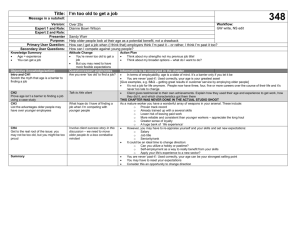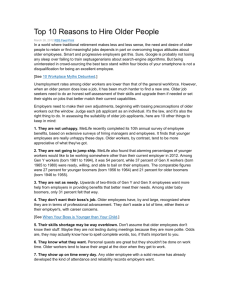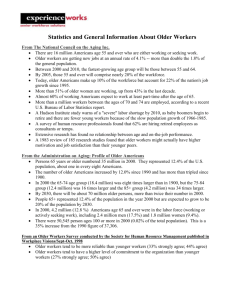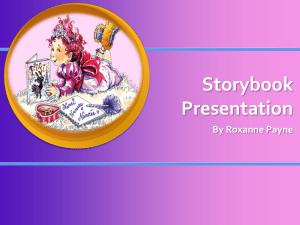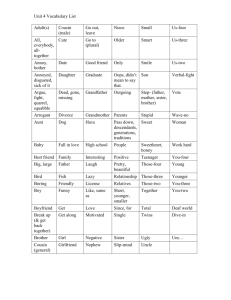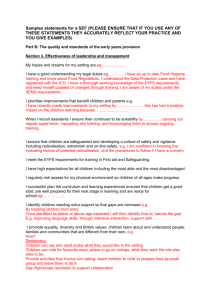Valuable or a drain: perception of employment for 50+
advertisement
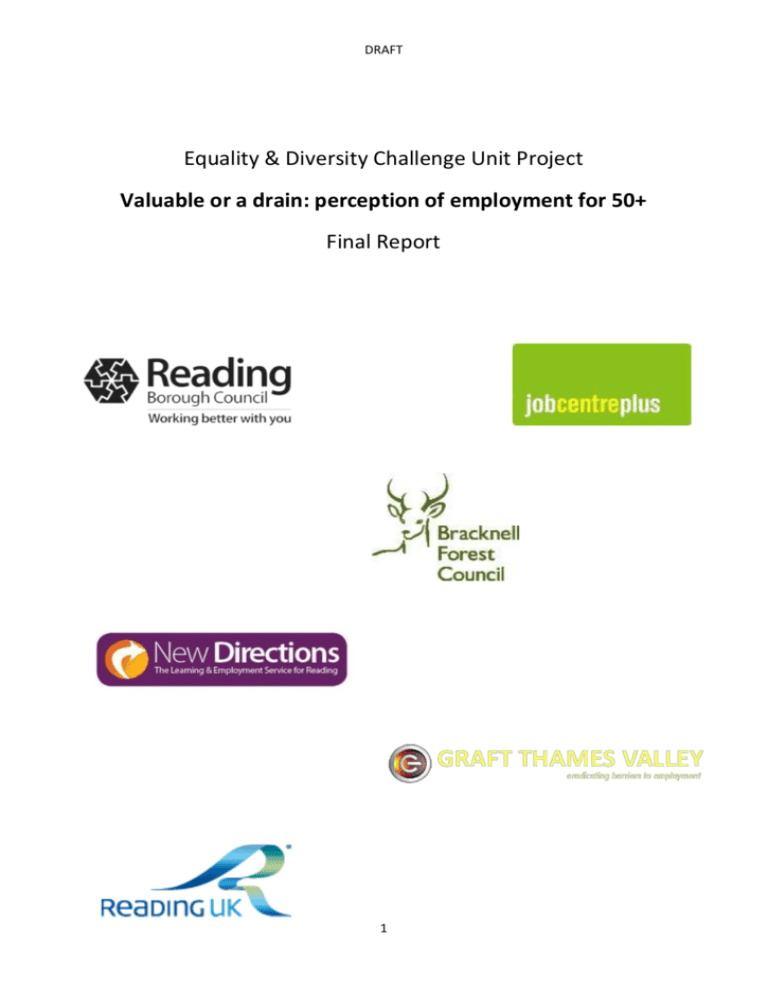
DRAFT Equality & Diversity Challenge Unit Project Valuable or a drain: perception of employment for 50+ Final Report 1 DRAFT Contents Summary ................................................................................................................................................. 3 Introduction ............................................................................................................................................ 3 Context .................................................................................................................................................... 3 Method ................................................................................................................................................... 4 Findings ................................................................................................................................................... 5 Practitioner Resources ............................................................................................................................ 8 Appendix 1 - Face to Face interview notes ............................................................................................. 9 Appendix 2 - Summary Questionnaire responses – Employers ............................................................ 17 Appendix 3 - Summary Questionnaire responses – Individuals ........................................................... 23 Appendix 4 – References/Links ............................................................................................................. 34 2 DRAFT Summary A partnership of organisations supporting those distanced from the labour market in Reading carried out an ethnographic study to explore perceptions of employing individuals aged 50+. The stratified sample elicited feedback from 77 people representing those individuals and employers. Tools were developed to help practitioner’s better support individuals. The key finding of the research was that habitus of employers and individuals perceptions as employees are both positive and negative. This research was funded by the Equality and Diversity Challenge Unit. Introduction Reading Borough Council, Bracknell Forest Council, Job Centre Plus, Reading UKCIC and Graft Thames Valley are all organisations who support the over 50s into employment and are trying to develop a wider understanding of 50+ employment issues via disseminating resources for a range of practitioner e.g. advisors, teachers and HR staff, that challenge negative perceptions of 50+ employment. Context The 2011 Census estimates the population of Reading at 155,700. This a 9% increase on the 2001 census figure of 143,096 and a 2% bigger change than the one between 1991 and 2001 when there was 7.1% increase in the Reading population. Reading's population has increased in ethnic diversity. 25.3% of the population is now currently 'non-white', a 12.1% increase since 2001. Reading continues to have the second highest proportion of non-white ethnic groups in the South East after Slough. 85.5% of resident’s are in good health. Professional occupation types have shown the most significant increase since 2001 census 24.5% of the Reading Population employed in this sector, well above the regional and England percentage of 18.7% and 17.5% respectively. Managers, Directors and senior officials have reduced by 6% for Reading and by similar levels in the South East & nationally. Service occupations have increased and administrative occupations decreased. Other occupation types are reasonably static compared to 2001 census results. Reading’s employers are predominantly Micro and Small employers. Job density levels indicate there are sufficient jobs for the local population. 3 DRAFT Method 18 Face to Face interviews were carried out by three partners: Graft Thames Valley, Reading UKCIC and Bracknell Forest Council. 9 electronic surveys were completed by other companies. 52 Individuals who were unemployed or who had recently gained employment aged 50+ completed a questionnaire electronically or in hard copy. Job Centre Plus was an essential partner in reaching individuals and capturing their responses. At least 19 individual responses were from JCP clients. Four 50+ unemployed individual’s undertook work experience placements with Reading and Bracknell Forest council’s. Case studies were gathered and capitalised upon when opportunities arose. The ethical statement was “The data gathered in this questionnaire shall remain completely anonymous; no information about the respondent is collected. Honest responses are fundamental to this project. We encouraged respondents to be as open as possible. The purpose of the questionnaires was to find out what perceptions really are. We hope that this research can inform future practice and or research.” 4 DRAFT Findings Employers From the employers surveyed two thirds feel there are barriers to employing staff aged 50+. These perceived barriers are often attributed to adaptability and re-training to maintain their competitiveness against younger rivals. Most acknowledge that staff aged 50+ could be better at handling conflict or difficult situations. Many felt that staff aged 50+ would be more motivated and could make good mentors or role models. More than half felt their responses would be different for staff aged 60+ and 70+, citing health or physical strength as a concern. Individuals From the individuals surveyed two thirds feel there are barriers to employing staff aged 50+. Most felt better able to handle conflict or difficult situations, were adaptable, were more trustworthy and that their interpersonal skills were better. They felt more motivated and reliable, and that they would make good mentors or role models. Two thirds felt that they would have more IT training needs. Most felt that valuable experience was often overlooked. Work Placements 8 Week work experience placements were offered. The intended benefits to participants were: Development of IT skills including: inputting of data, use of excel for collation & analysis of responses Development of administration skills including: completing questionnaires with others or being interviewed as part of the in depth face to face interviews Development of presentation skills including: participation in workshops and disseminating results Developing resources including: working with others, sharing ideas and team working Hazel: at interview this lady was excessively nervous and was absolutely desperate to get back into work. She had been out of work for 10 years and is 60+. Her nerves and lack of confidence really was 5 DRAFT a barrier to gaining work. Once she started the placement we saw a completely different individual. Hazel has a strong background in administration and was very quickly an asset to have around. She was proactive, seeking out jobs to do if one hadn’t been allocated, and looking to support all areas of the reception / admin placement role. At the end of the placement she was ill for a little while but rapidly quickly found an admin role for a laundry company. It isn’t what she wants to do in the long term but it is a real job where she can build on the confidence she was struggling with before her placement. Vincent: an unassuming, quiet gentleman who took on the tasks allocated in a quiet, conscientious way. He marked initial assessments for English and maths. He helped to set up filing for an Ofsted folder, typing up policies / procedures. He contacted learners to ask them to collect their portfolios. He made labels to make portfolios clearly and easily identifiable. He completed tasks with minimum direction, independently fulfilling tasks. He checked if he had questions. He used his initiative when completing tasks to improve the quality of the tasks. He had a very positive attitude and was patient. He undertook a range of tasks very graciously. He has one week left on his placement which was extended due to ill health and he has applied for jobs whilst on placement. We are very hopeful that he will find work after his placement. A Case study: At a recent interview day, a member of the research team encountered the following: Application forms: 1) Even though there was no date of birth on the application forms, a member of the short-listing panel had written the applicant's age at the top of each application form and photocopied these "age added" forms for the interview panel (calculated roughly from the dates of GCSEs or GCEs). Discussion amongst the interview panel of six after interview included: 1) Possible lower levels of stamina of the older candidate in terms of his age compared with the younger candidate. 2) The possible lack of willingness of the older candidate to work long hours compared with the younger candidate in terms of his age. The term "winding down to retirement" was used. 3) The possible lack of willingness of the older candidate to undertake further training compared with the younger candidate. 4) The possible lack of flexibility of the older candidate to adopt newer ways of working compared with the younger candidate. 5) How many years there may be before the older candidate’s retirement. 6 DRAFT The younger candidate was chosen in favour of the older candidate and, although the discussion was wider than the topics above, it is fair to say that the age factor dominated the discussion. Links to wider studies The Recruitment & Employment Confederation (REC) and Age UK published a “Best Practice Guide for Recruiters” June 2015. The document calls for a greater commitment from recruiters and some of its recommendations mirror our findings. These are summarised as: It’s about individuals not stereotypes Be mindful of the language used as it may put off older applicants Age is not an indicator of ability Statistical evidence published by Business in the Community (BITC) in October 2014 also suggests that older workers are disadvantaged: one-third (33%) of unemployed people aged between 50 and 64 started their own business, compared with a quarter of those aged between 30 and 49 and 8.6% of those aged between 16 and 29; among those 50-64-year-olds who moved out of unemployment, 16.3% found a place on a government employment and training scheme, in contrast to 11.1% of those in the 1624 age group and 12.7% of those in the 30-49 bracket; unpaid work for a family business is reported at higher levels (10.6%) among the 50-64 age group; health and illness concerns restrict the opportunities that older workers are able to pursue; and other disincentives to return to work may also exist when people receive income from benefits or pensions and a return to work would negatively impact their finances A larger DWP study exploring attitudes towards employing older people also produced comparable findings; “Among those currently unemployed or not working, 50 per cent agreed that it was difficult to get another job. Furthermore, 51 per cent agreed that age affected their confidence in applying for jobs and 57% agreed that they felt employers were not interested in hiring them because of their age (49 per cent of women and 68 per cent of men). Thirty nine per cent agreed that applying for jobs was difficult because their skills were out of date.” In a recent CIPD survey, workers were asked to identify the benefits of working within an age-diverse team. They cited having different perspectives, knowledge sharing, new ideas and improved problem solving as major advantages. The report also indicates there is no correlation between age and performance. 7 DRAFT Practitioner Resources Age is one of the major hurdles that hinder successful searching for jobs; however more evidence exists to disprove outdated stereotypes and challenge unconscious bias and age discrimination. Other non-age specific barriers include low skills, or qualifications, long-term health conditions, disabilities and combining work with caring. Many over 50s are affected by some or all of these factors, with older women particularly at risk. Awareness of age friendly employer policies could be helpful: Flexible working Flexible/phased retirement Home working Health and wellbeing provision Free/subsidised medical care Pre-retirement training Family care leave Gap breaks Hot-desking Flexible job design policies Financial planning guidance Return-to-work options for retirees Offer insurance provision (to cover long-term health and sickness, disability absence and rehabilitation) Support networks for the retired Particular characteristics of older workers which businesses value highly include: experience of work and life experience loyalty reliability good time management skills patience and calmness under pressure ability to engage well with other people strong customer service empathy ability to mentor younger staff 8 DRAFT Appendix 1 - Face to Face interview notes Company 1 Company 1 is a small printing company that has operated in Reading for over 50 years. They currently employ 100% staff over 50 – however, they have not recruited for over a decade and many staff have become over 50 whilst in their employ. Company 1 is very pro employing an older workforce. If there were two equal candidates for a role and one of them was over 50 they would probably appoint the older person. However, they would not discriminate in favour of someone over 50 – they would appoint the best person for the job. Company 1 is concerned that younger applicants may be joining the business as a stepping stone to bigger things in their career – whilst in this company’s experience older people tend to stay longer giving better staff retention – this company has not recruited for over a decade. Company 1 thinks that people over 50 have the relevant life experiences to handle conflict and difficult situations diplomatically – even if they did not agree with a colleague they would manage the situation without causing embarrassment to others. This company feels that there are no age limits for recruitment if the person can do the job they say that ‘it’s what’s in the head that counts’. Company 2 Company 2 is a small business that provides administration services to the wider business community including telephone handling and call centre support – as such the business is heavily reliant on IT. The company employs a mixed age workforce and has a robust induction and training process. As each new client they support has a unique requirement, staff are regularly required to be trained in both new client requirements and the IT process that will support the new client business. Company 2 does not see any significant differences between employees who are over 50 and those under 50. They feel that across the age range there is a mix of people that are good at some things but not at others and there is no specific thing they could single out for employees over 50. Company 2 feels that people over 50 are less stressed about work – generally speaking they are at a time of life when financial commitments (mortgage, children etc.) are easing, giving them the option to choose the job they want to do rather than a job that pays well. As a result over 50’s in Company 2 show good commitment, team working, motivation and reliability – they have chosen the job they want, if they became uncomfortable in that job they would leave. When asked about the IT training needs of over 50’s, Company 2 saw no difference between them and under 50’s. They described the IT requirement within the company as a ‘wave that is getting bigger’ and, recognising this issue, they only expect staff to be trained in IT that is relevant to their particular role – e.g. they don’t expect call centre staff to understand and engage in social media. Where training is required Company 2 find over 50’s as adaptable as any other age range within the business and cited the rise in Silver Surfers as proof of the over 50’s ability to adapt to technology. When questioned about the suitability of over 50’s as mentors/role models Company 2 do not have a mentor programme. They have found some resistance when they have approached older staff to take on mentoring roles – the general feeling being that it is ‘more than I signed up for’. However, 9 DRAFT by not having a formal policy, mentoring/role models has developed informally ‘by stealth’ with older employees being more than prepared to help younger staff albeit on their own (informal) terms. Concerning staff aged 60+ or 70+, Company 2 had concerns about fitness and health. Company 2 felt that eventually we are all going to wear out –but is concerned at the impact on the business (liabilities) if a serious incident (not connected with work) happened in the workplace – e.g. a stroke or heart attack. Company 2 suggested some things for future research – 1. Is there any research into the efficiency of older people in the workplace – e.g. does efficiency tail off as we get older and if so are there any tactics to overcome this? 2. As we get older the time passes faster- is this a perception or are we working smarter? 3. What are the liabilities for an employer of someone say over 70? There is a concern that the company could be liable, or blocked with red tape, if a serious incident happened at work. 4. RSI is a notifiable illness – are older people more susceptible to RSI? Is there any public education around employing older people – are they more likely to need additional in-work care? Company 2 felt that clarification around the health and safety element would help to ‘sell’ older people to employers. Clarification on this issue would motivate the company to employ more older people – more so than tax breaks or other financial inducements. That said, they will always recruit the best fit for the job. Company 2 also shared a concern about the social impact of actively recruiting over 50’s and expressed a concern about the impact on younger people trying to get their first job / apprenticeship. Company 3 Company 3 is a small training company. They tend to buy in resources when required and they have a strong equalities policy. Company 3 feel that over 50’s do have the experience required for this sector but they don’t always realise this. They generally present as less skilled than younger people but their experience would make up for this if they realised it – it could therefore be an issue with their own self confidence. Company 3 finds the attitude of over 50’s generally better than younger staff but does acknowledge that they are competing against newly qualified younger staff with more up to date IT sills. Company 3 feels there is a perception that over 50’s in this sector are ‘old school’. Company 3 feels that over 50’s have the life experience that gives them the edge to deal with difficult situations and conflict and in some areas over 50’s are much more skilled than younger people – e.g. their interpersonal skills are excellent and they understand that commitment is an integral part of life. They are also reliable and they understand that things sometimes go wrong and when they do older people can deal with situations and move on. They are also good team players as they don’t have anything to prove – focusing on getting the whole job done rather than feeling the need to show off just their bit of the job. Life experience has taught them not to ‘suffer fools’ but also to have humility in dealing with situations – making them patient and supportive of others. On the downside, Company 3 would assess over 50’s as generally being less adaptable. They get set in their ways and find it harder to take on new ideas – e.g. paperless working. When they do adapt it 10 DRAFT tends to take them longer than a younger person. There is a resistance to learn new things and ways of working and a lack of acceptance that keeping up to date with technology is essential in this sector. However, when they do take on a new task they are generally very good delegators. When questioned about flexibility in the workplace of over 50’s Company 3 felt this very much depended on the individual and the circumstances. Company 3 felt that over 50’s in general feel they don’t have to be flexible and that it is a matter of choice. Company 3 felt than in this sector there is an untapped workforce of people aged over 50 whose jobs have become redundant in the current economic climate and that whilst they have very valid experience they cannot compete with younger people with more recent qualifications. Company 4 Company 4 is a small business providing social care. They do feel that there are barriers for people over 50 in this sector –the main one being attitude. Over 50’s tend to hold old fashioned ideas about things like mental ill health and as such may be more judgemental than younger people. Company 4 feels those over 50’s that do enter this sector have lots of relevant life experience and this makes them excellent at managing challenging behaviour. In Company 4’s experience, the over 50’s that join their business tend to belong to strong faith groups and spirituality is very evident in their working lives. Company 4 feels this would make over 50’s more trustworthy and more committed to their work – leading to them being more reliable, motivated and patient. As older people they are less likely to ‘need’ a job for purely financial reasons and there choose to do the jobs they do. Company 4 feel this links back to their faith and spirituality and their motivation to make a difference. When questioned about the role of over 50’s as mentors or role models Company 4 had mixed views. They felt that their strong faith ethic gave them the motivation to help and support and this is commendable, but that this could lead to dependence from the people they are supporting – ie mentees and those looking for role models. Company 4 summed this up as ‘over 50’s are great service providers but not great mentors’. Company 4 saw no real difference between employing over 50’s and those over 60 or 70 – providing they can do the job. Physical fitness has not been an issue for Company 4, although older workers are sometimes unable to join service users in activities (gym, swimming, dance classes etc.) which is something Company 4 promotes. Company 4 does not actively recruit over 50’s and would always employ the person best suited (usually in temperament) for the job. All staff require formal training in delivering social care and cannot be confirmed in post until this is completed. Company 4 finds over 50’s as able as younger staff to complete this training requirement. Company 5 Company 5 is a resourcing business that fluctuates between being a small and a medium sized business. Company 5 specialises in IT and business management. Company 5 has a strong commitment to diversity in the workplace and does not experience any barriers themselves to 11 DRAFT recruiting over 50’s. However, they resource staff for other businesses and they do see barriers in other businesses. These are mainly around lack of qualifications. As the IT business develops faster than almost any other it is important that people can specialise – i.e. understand the training requirements around their specific bit – but older people can find it difficult to regress the learning curve. There is a need in this sector to change skills set as people move up the employment hierarchy and older people won’t learn new technology (or feel they don’t need to), making them less ready for jobs in this sector. Attitude is also seen as a barrier – a comparison was made between IT and manual labourers; as labourers get older they are not as efficient as younger labourers – in IT, some workers in their 50’s slow down mentally. Company 5’s business is high stress and (generally) has a carnivore attitude. Whilst life experience should make over 50’s more able to cope with conflict and difficult situations, in this sector the younger workers are more resilient and older workers tend to get upset. However, older people generally have a higher standard of education and good base skills – making them more adaptable and with better interpersonal skills. As work in this sector is not manual, physical strength tends to fall into socio-economic groupings with the more affluent people being generally more physically fit. Over 50’s in this sector tend to be more committed at work but, sadly, this is because they are glad to have a job at all. Motivation varies; the benefits system can work against motivation to work, but those that do work in this sector tend to be more conscientious and have a robust work ethic and to be more reliable. Because of the need to specialise in this sector, people are recruited with very detailed job specifications – therefore if things like team working, patience and the ability to mentor are required, people will be recruited for those skills. If those skills are not required they will not be monitored. Company 5 would not change their responses when questioned about staff over 60 or over 70. However, they did refer to their earlier comments about the size of the IT industry, the need to specialise to keep their skills up to date. Company 6 A large national construction company and as such has to navigate a lot of ‘red tape’ to take part in a survey. Due to the large number of policies and processes that large companies require, Company 6 gave the least amount of feedback and was not totally comfortable with the interview. Company 6 does feel that there are definite barriers to employing people aged over 50 in the construction industry and at all levels and they cite the main barrier as attitude. Company 6 states that over 50’s who do enter the sector bring a wealth of experience and understanding into the workplace environment. Health and related issues can be a problem as speed and flexibility can be a source of contention among staff, particularly in a manual role and older staff members can be considered as vulnerable with related time and cost issues arising. Company 6 does have an active recruitment policy to attract staff aged over 50. However, they were not confident that this would extend to over 60’s or over 70’s. 50% of companies surveyed feel there are no barriers to employment for people aged over 50 and 50% of companies feel there are barriers. Attitude was the barrier most frequently mentioned. 12 DRAFT Company 7 A small Local Authority. They employ a large number of people in the category and age is no barrier when assessing applications. Consideration is given to ability, experience and fitness should the position require it and there may be occasions when this could be a barrier if the candidate does not appear to have the fitness level required to do the job. This obviously, could also apply to younger applicants. The HR person interviewed thought that the positive aspects of employing over 50s far outweighed the negative and talked about commitment, attitude, work ethic and reliability as positive attributes which quite often were part of an older person’s attitude to employment. Negatives could be a lack of up to date IT skills and finding it more difficult to learn various operating systems. Younger employees were more likely to ‘hit the ground running’. Company 8 A large Housing Association. They echoed the comments of the Local Authority but also talked about the lack of trade skills present in younger people. They have a large maintenance programme running, some of which is subcontracted but they do employ trades people and the skills required usually present in older candidates. This can bring its own issues with physical fitness and long term health issues both being mentioned. They also mentioned that occasionally, older employees can be a little less flexible ‘its not my job’ sometimes being mentioned. The felt that administrative positions tended to favour older candidates as they were quite often part-time, which appealed to people who wanted to ‘downsize’. To sum up they felt that age would not be a barrier at all provided the candidate had the right qualifications, fitness levels, attitude and personality to fill the role. Company 9 A small Plumbing and Heating business. The owner hadn’t really considered the employment of somebody over 50 previously but couldn’t see why it would be a barrier. However, as the discussion progressed, various issues were raised, which suggested difficulties may arise. He mentioned that quite often older trades’ persons were ‘stuck in the past’. They were less likely to adopt new concepts and even less likely to conform to current legislation. When I asked him how he had reached these conclusions he said that he spent a good deal of time in wholesale suppliers and that trades people tended to chat when collecting supplies. He also said that being a younger person himself, he thought an older person maybe more difficult to manage but that could just be his inexperience. Company 10 A Tree Surgeon/Landscaping company. He employs both practical and administrative staff and didn’t feel that being 50+ was particularly a barrier. However, further discussion revealed that he was much more like to employ an older person in the office. He said that the work outside was extremely physical and demanded a high level of fitness. He thought on reflection that he maybe biased towards a younger person because of this. He was keen to point out that he did have older workers in his team but they had been with him for a long time and he didn’t really consider their age as a barrier – he didn’t consider their age at all. Both his administrative employees are older – 13 DRAFT one 56 the other 48 and should he take on more staff or if one of them left, he would be happy to employ somebody who was 50+, indeed it was highly likely. He also mentioned women with young families had been a problem for him in the past but he was aware of discrimination laws. Company 11 A Restaurant. The employer has a large staff, consisting of chefs, kitchen porters, waiting staff, bar staff, takeaway delivery staff and cleaners. The team is made up of all ages but the older members tend to be those manning the phones taking orders for takeaways and delivery drivers, who work casually to top up their incomes. He said that culturally, older people in his community tended to take on more advisory roles but he didn’t have any particular problem with employing a 50+ person in any position, provided they had the right attributes for the job. He felt that older candidates/employees were calmer and less likely to panic when the restaurant was busy, which at weekends it often is. They were also more reliable and he gave an example of somebody calling in sick at the last minute and it always seemingly being an older casual worker dropping everything to fill in. He felt that older workers set great examples to younger staff although they could sometimes be seen as judgemental. Company 12 Provides housing support for vulnerable adults. The company is an equal opportunities employer and they were very keen to stress this. They employ several staff in the Bracknell area as Support Workers and said age was no barrier when it came to working in their organisation. Employees are mainly female and ages range from 26 to 61 currently. The employer felt that all ages brought essential qualities but that age sometimes brought impatience, and older workers were much less accepting of disadvantage. Older people were more reliable, trustworthy motivated and no nonsense which could be both positive and negative, depending on the client. Careful consideration was given, therefore, when allocating clients to workers. They said that they sometimes teamed an older worker with a young person and this worked very well. The older person brought a wealth of experience whilst the younger employee was more likely to be accepting of new ideas. It was mentioned that technology could sometimes be an issue for older people and usually if there was a problem with recording details on their IT system, it would be a 50+ support worker who had misunderstood. Company 13 Is a small software company, with 10 permanent members of staff and occasional casual/contract staff The MD is clear that there are barriers to employing older staff reflecting the nature of his business and its rapid changes, so these are very much around experience and skills, since the over 50s are not seen as in tune with the latest developments in software management. While recognising the skills of older staff in handling conflict, the MD did not feel older staff were as adaptable, or as willing to embrace change or new skills as younger team members are. Things like physical strength, or health record wouldn’t be seen as an issue but in terms of being “better” than young people in areas like trustworthiness, interpersonal skills or team working the 14 DRAFT respondent was doubtful. Having a young team means that the company shares a certain outlook, and way of working that an older employee might not fit into even if he/she was motivated. There was also an interesting point made about the Over 50s looking towards retirement or being in “wind down” with less interest in career development. On the upside it was felt that older people could be very good mentors and if the company expanded enough someone over 50 would certainly be considered for a HR type role, or possibly admin type work where an eye for detail and steady approach would be useful. However they would be VERY unlikely to recruit someone in their 60s or 70s Company 14 Is a larger SME, employing upward of 70 people in the hospitality field, including hotel restaurant and bar facilities. The company is privately owned and part of a national marketing franchise. Conversation took place with the General Manager, himself over 50, who has a long track record in the industry. He felt that there were some barriers to employment of the over-50s, which tended to be around levels of fitness and willingness to work unsocial hours – although he has recently recruited some ex-army team members who do work nights and are very fit. The use of Over50s in roles such as night porters/security and bar staff has been successful as the maturity of approach and trustworthiness is better than many young people. Normally the older staff are adaptable, and because they are happy to have found work (esp if there has been a gap in employment) very willing to contribute and play a part in the team, and extremely reliable. Interestingly motivation and career development were more problematic – there was a sense that older employees were happy with status quo, had no interest in training or promotion. So while they would put themselves out to take on shifts, or support other work areas, there was no sense of progression, or wanting to learn IT skills, or even provide mentoring. Generally, while the GM doesn’t always think of mature people first for roles – there have been successes in recruiting older staff, though some roles would not be “suitable” eg would have back office/admin staff but wouldn’t think of over 50’s for gym or reception work. It is unlikely people in mid 60s or 70s would be taken on, because of the physical nature of the work, and real concerns over health and fitness for older people ie likely to cost the company in sickness, or coping with long term health issues. Company 15 Is a privately owned recruitment company with less than 50 employees, who were able to provide background across a range of key sectors, and relate the issues they have when finding work for Over50s clients. A conversation took place with one of the partners. It was felt that there were some issues around recruiting the Over 50s, but these were very much dependent on the sector the person works in, their skills set and the individual’s own attitude. 15 DRAFT The example was given of engineering – a sector with skills shortages where someone with a strong CV, whatever age, would be in demand. The problem is more around lower skilled jobs, especially physical roles in construction where the individual needs to learn new skills sets, and may not be willing. Recruiters often come up against barriers of the client’s own making – they believe they should be able to do the same job until they retire, and are very resistant to “demotion”. Or conversely they want a “quiet life” as they head towards retirement, with no stress or responsibility. A real issue around confidence does exist: recruiters often have to do a lot of work to convince applicants that they are up to a job, or have a skills set that would adapt to other career paths, so there is definitely fear of change among some. Health issues were also mentioned – blood pressure, diabetes etc, are very real issues which might make recruitment tricky. Partly for this reason they wouldn’t usually work with anyone over 60s. Overall the right person with the right attitude will walk into a job fairly easily in key sectors, though definitely not sales type roles where employers want young, aggressive and “attractive” people. Company 16 Is a large, international hotel chain, employing over 100 staff locally in hotel, leisure centre and bar/restaurant functions. The General Manager discussed recruitment practises, but did stress that policy was very much set by Head Office, which is reactive to national issues. The GM felt that there were very real issues around employing over50s which were more around fitness and health levels than anything else. Although the image of the company as a glamorous, 4 star venue was also a consideration when looking at front-line staff. Having said this the hotel has many over50s working in a variety of roles, though often staff who have been with the group for a long while, and have excellent skills sets or in back-office/security roles on lower skills. Responses to the perception of skills of older workers were similar to other respondents – good at handling difficult situations, trustworthiness and commitment to the company, but not as adaptable or interested in learning new skills as younger people. The approach to service was also mentioned, the feeling being that younger staff were easier to train to a high service standard level, with a customer focus. The right person can be a real role model / trainer for younger team members, but in practise older people not always interested – it is very much down to the individual, which isn’t really an age issue. The same is said for team working, some individuals love it, others prefer their own contained areas. The company has an equality policy and will not exclude over 50s from the recruitment process, but they are very unlikely to recruit people in their 60s and 70s. 16 DRAFT Appendix 2 - Summary Questionnaire responses – Employers 17 DRAFT 18 DRAFT 19 DRAFT 20 DRAFT 21 DRAFT 22 DRAFT Appendix 3 - Summary Questionnaire responses – Individuals 23 DRAFT 24 DRAFT 25 DRAFT 26 DRAFT 27 DRAFT 28 DRAFT 29 DRAFT 30 DRAFT 31 DRAFT 32 DRAFT 33 DRAFT Appendix 4 – References/Links http://www.cipd.co.uk/binaries/avoiding-the-demographic-crunch-labour-supply-andageing-workforce.pdf http://www.bitc.org.uk/our-resources/report/missing-million-pathways-back-employment http://beta.reading.gov.uk/boroughprofile http://www.personneltoday.com/hr/rec-age-uk-produce-best-practice-guide-recruitershiring-older-workers/ http://www.ageuk.org.uk/Documents/EN-GB/For-professionals/Policy/work-andlearning/Age_Opportunity_Best_Practice_Guide_for_Recruiters.pdf?dtrk=true https://www.gov.uk/government/uploads/system/uploads/attachment_data/file/411420/anew-vision-for-older-workers.pdf https://www.gov.uk/government/uploads/system/uploads/attachment_data/file/394642/at titudes-over-50s-fuller-working-lives.pdf https://www.cipd.co.uk/binaries/managing-an-age-diverse-workforce_2014.PDF Guidance: Help and Support for Older Workers, Department for Work and Pensions (2015) www.gov.uk Employing Older Workers: An employer’s guide to multi-generational workforce, Department for Work and Pensions (2013) www.gov.uk DWP Employer Toolkit: Guidance for Managers of Older Workers, Age Action Alliance www.ageactionalliance.org Age UK: www.ageuk.org.uk/latest-news or www.ageuk.org.uk/work-and-learning ACAS: www.acas.org.uk Equality and Human Rights Commission: www.equalityhumanrights.com The Employers Network for Equality and Inclusion: www.enei.org.uk The Age and Employment Network: www.taen.org.uk The 50+ Works Guide for welfare to work providers: www.50plusworks.com 34 DRAFT Appendix 5 – Work placement Details Person Specification Qualifications Work Placement Volunteers must be able to communicate clearly in both spoken and written Standard English. Skills/personal qualities Work Placement Volunteers must have good interpersonal skills. They must be good listeners and be able to establish a rapport with people from a variety of backgrounds. Patience and a positive attitude are essential. Work Placement Volunteers should be reliable, giving advance notice of absence whenever possible. They should be discreet and observe confidentiality. They should be capable of establishing a professional yet friendly relationship with people, without becoming over involved. Volunteers should demonstrate a willingness and ability to learn. They should be aware of and comply with H&S rules, and the service’s Equal Opportunities policy. Details: These placements will be offered at New Directions, Reading and at the Open Learning Centre, Bracknell Placements to run in line with the project from February 2015 to August 2015 DWP will cover transport costs / interview attire for eligible work experience candidates If interested please ask to be referred by your Job Centre Plus Advisor. 35

